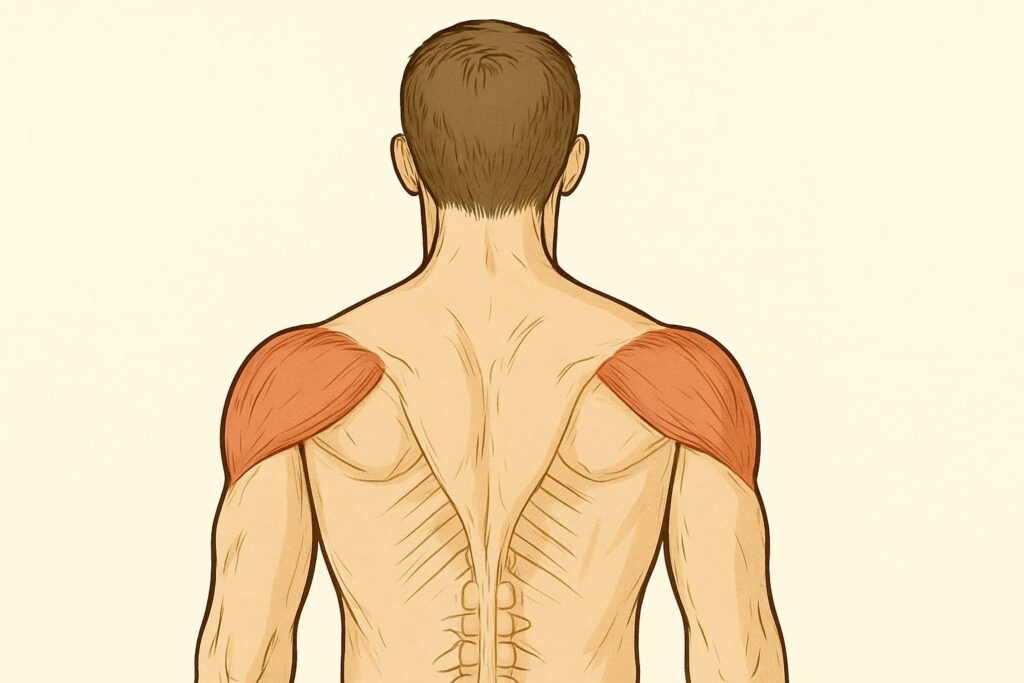The Best Exercises for Deltoids with and without Weights
Strong, sculpted shoulders not only improve your appearance but also enhance upper-body strength, posture, and performance in every workout. Whether you train at the gym or prefer exercising at home, finding the best exercises for deltoids with and without weights can completely change your fitness journey.
In this complete guide, you’ll discover how to work all three parts of your deltoids: the anterior, lateral, and posterior heads, using both resistance equipment and bodyweight movements. Let’s unlock the secrets to building round, powerful shoulders that turn heads everywhere.

Understanding the Deltoids
Before jumping into the best exercises for deltoids with and without weights, it’s essential to understand how your deltoid muscles work. The deltoid is a three-headed muscle that wraps around your shoulder joint:
- Anterior Deltoid (Front): Responsible for lifting your arm forward, crucial for pressing movements.
- Lateral Deltoid (Side): Helps raise your arm to the side and creates that “capped” look.
- Posterior Deltoid (Rear): Assists in pulling motions and maintaining shoulder stability.
Balanced training across all three areas is the key to strong, well-shaped shoulders, and this article will show you exactly how to achieve that balance.
The Best Deltoid Exercises with Weights
When it comes to shoulder development, weights are your best ally. Dumbbells, barbells, and cables provide the resistance needed for muscle growth and definition. Below are the best exercises for deltoids with and without weights, starting with weighted versions.
1. Dumbbell Shoulder Press
A timeless classic and a pillar of shoulder training.
Sit or stand tall, hold dumbbells at shoulder height, and press them overhead until your arms are fully extended. Slowly lower back down.
Tip: Keep your core tight and avoid locking out your elbows for joint safety.
This move primarily targets the anterior and lateral deltoids.
2. Arnold Press
Created by Arnold Schwarzenegger, this variation keeps tension on your shoulders throughout the entire movement.
Start with palms facing you and rotate outward as you press the dumbbells overhead.
The continuous rotation hits all three deltoid heads effectively, making it one of the best exercises for deltoids with and without weights for overall growth.
3. Lateral Raises
If your goal is to achieve wide, round shoulders, this exercise is non-negotiable.
Hold light dumbbells by your sides, then lift your arms outward until they’re parallel to the floor.
Focus on slow, controlled motion: it’s not about heavy weights but precision.
Transition tip: As you fatigue, you can slightly bend your elbows to maintain good form without straining your joints.
4. Front Raises
Perfect for sculpting the front delts.
Raise a dumbbell in front of you until shoulder height, then slowly lower. You can do this with one arm at a time or both together.
It’s a simple yet powerful move that enhances shoulder definition and posture.
5. Rear Delt Fly
The most underrated move for balanced shoulder development.
Bend forward slightly at the hips, keep a flat back, and lift the dumbbells outward in a “T” shape.
You’ll feel your rear delts fire up, vital for preventing shoulder rounding and improving overall aesthetics.
6. Upright Rows
Using a barbell or dumbbells, pull the weight up toward your chin, keeping elbows higher than your wrists.
It works the lateral delts and traps together for thicker upper shoulders.
Be cautious not to use too heavy a weight: smooth control ensures maximum engagement and avoids shoulder impingement.
The Best Deltoid Exercises without Weights
No equipment? No problem.
You can still build impressive shoulders at home using bodyweight movements and resistance from your own body. These are the that require no gym access.
1. Pike Push-Ups
An advanced push-up variation that targets the shoulders more directly than standard ones.
Start in a downward dog position and bend your elbows to bring your head closer to the floor. Push back up with control.
This mimics an overhead press using just your bodyweight.
2. Wall Walks
A great stability exercise that also strengthens your entire shoulder girdle.
Start in a push-up position facing a wall, then “walk” your feet up the wall as your hands move closer until you’re nearly vertical.
Hold for a few seconds before walking back down.
It’s intense but highly effective for shoulder strength and balance.
3. Handstand Hold or Handstand Push-Up
For those looking to challenge themselves, handstand holds are the ultimate bodyweight shoulder builder.
Kick up against a wall and hold your position, engaging your core and delts throughout.
Once you’re comfortable, try handstand push-ups for advanced hypertrophy training.
Transition tip: Gradually progress from pike push-ups to handstands to reduce injury risk.
4. Arm Circles and Shoulder Taps
Small, controlled movements can also contribute to shoulder endurance and tone.
Perform forward and backward arm circles for 45 seconds each, then transition into shoulder taps from a plank position.
These exercises may look simple, but they activate your delts and improve joint stability, especially when done regularly.
5. Plank to Downward Dog
Start in a plank and push your hips up and back into a downward dog position.
This flowing motion strengthens the front delts while promoting flexibility and mobility.
Repeat the sequence for 30–45 seconds to enhance shoulder endurance and control.
Combining Weighted and Bodyweight Exercises
To get the most out of your shoulder workouts, the secret lies in mixing the best exercises for deltoids with and without weights.
Alternating between both methods improves muscle strength, endurance, and control, while preventing plateaus.
Here’s a simple hybrid routine to try 2–3 times per week:
Hybrid Deltoid Workout Plan
- Dumbbell Shoulder Press – 3 sets of 10 reps
2. Pike Push-Ups – 3 sets of 8–10 reps
3. Lateral Raises – 3 sets of 15 reps
4. Rear Delt Fly – 3 sets of 12 reps
5. Plank to Downward Dog – 3 rounds of 30 seconds
6. Arm Circles Finisher – 2 rounds of 45 seconds
Transition note: Rest for 60 seconds between sets to maintain intensity without overfatiguing your shoulders.
Common Mistakes to Avoid
Even the best exercises for deltoids with and without weights won’t deliver results if performed incorrectly. Keep an eye out for these frequent errors:
- Using too much weight: Shoulder joints are delicate. Focus on control, not ego lifting.
- Neglecting rear delts: A strong back balances shoulder development and prevents posture issues.
- Rushing through reps: Time under tension matters more than speed. Slow down to feel the burn.
- Skipping warm-up: Always do arm swings and light stretches before training to prevent strain.
Tips for Faster Deltoid Growth
- Train delts twice a week. They recover quickly and respond well to frequency.
- Prioritize form over weight. Better control means more muscle activation.
- Include variety. Combine compound presses with isolation moves.
- Don’t forget nutrition. Adequate protein intake supports muscle recovery.
- Get enough rest. Growth happens between workouts, not during them.
Transition reminder: As you progress, gradually increase reps or resistance: small, consistent improvements drive long-term gains.
Stretching and Recovery
After finishing your best exercises for deltoids with and without weights, spend 5–10 minutes stretching your shoulders.
Simple static stretches like the cross-body arm stretch or doorway chest stretch enhance flexibility and reduce soreness.
Foam rolling the upper back and shoulders can also speed up recovery, improving circulation and preventing stiffness.
Final Thoughts
The shoulders are one of the most visually impressive muscle groups, and training them correctly brings both aesthetic and functional benefits.
By combining the best exercises for deltoids with and without weights, you can build powerful, well-rounded shoulders anywhere, anytime.
Whether you’re pressing heavy dumbbells in the gym or mastering handstand holds at home, consistency is what truly shapes results.
So stay committed, train smart, and enjoy the confidence that comes with strong, defined deltoids.
